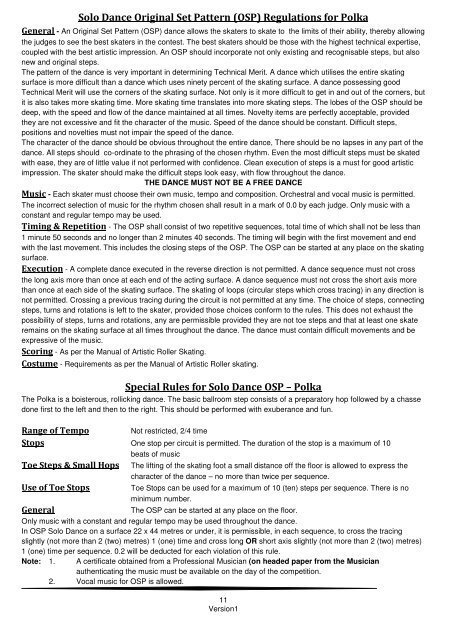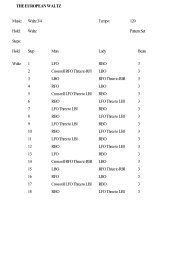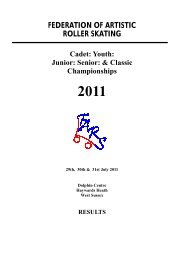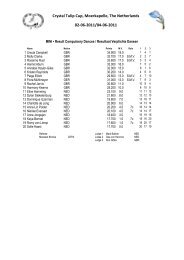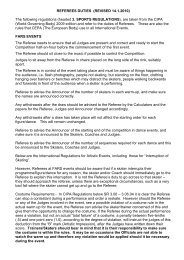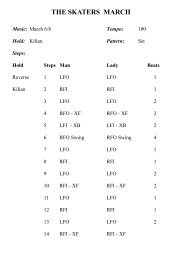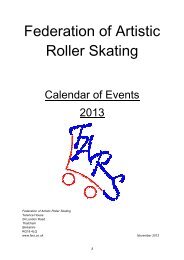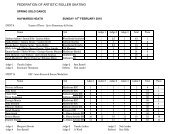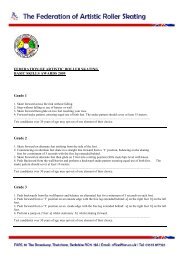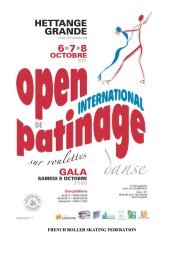FEDERATION OF FEDERATION OF ARTISTIC ROLLER SKATING ...
FEDERATION OF FEDERATION OF ARTISTIC ROLLER SKATING ...
FEDERATION OF FEDERATION OF ARTISTIC ROLLER SKATING ...
Create successful ePaper yourself
Turn your PDF publications into a flip-book with our unique Google optimized e-Paper software.
Solo Dance Original Set Pattern (OSP) Regulations for Polka<br />
General - An Original Set Pattern (OSP) dance allows the skaters to skate to the limits of their ability, thereby allowing<br />
the judges to see the best skaters in the contest. The best skaters should be those with the highest technical expertise,<br />
coupled with the best artistic impression. An OSP should incorporate not only existing and recognisable steps, but also<br />
new and original steps.<br />
The pattern of the dance is very important in determining Technical Merit. A dance which utilises the entire skating<br />
surface is more difficult than a dance which uses ninety percent of the skating surface. A dance possessing good<br />
Technical Merit will use the corners of the skating surface. Not only is it more difficult to get in and out of the corners, but<br />
it is also takes more skating time. More skating time translates into more skating steps. The lobes of the OSP should be<br />
deep, with the speed and flow of the dance maintained at all times. Novelty items are perfectly acceptable, provided<br />
they are not excessive and fit the character of the music. Speed of the dance should be constant. Difficult steps,<br />
positions and novelties must not impair the speed of the dance.<br />
The character of the dance should be obvious throughout the entire dance, There should be no lapses in any part of the<br />
dance. All steps should co-ordinate to the phrasing of the chosen rhythm. Even the most difficult steps must be skated<br />
with ease, they are of little value if not performed with confidence. Clean execution of steps is a must for good artistic<br />
impression. The skater should make the difficult steps look easy, with flow throughout the dance.<br />
THE DANCE MUST NOT BE A FREE DANCE<br />
Music - Each skater must choose their own music, tempo and composition. Orchestral and vocal music is permitted.<br />
The incorrect selection of music for the rhythm chosen shall result in a mark of 0.0 by each judge. Only music with a<br />
constant and regular tempo may be used.<br />
Timing & Repetition - The OSP shall consist of two repetitive sequences, total time of which shall not be less than<br />
1 minute 50 seconds and no longer than 2 minutes 40 seconds. The timing will begin with the first movement and end<br />
with the last movement. This includes the closing steps of the OSP. The OSP can be started at any place on the skating<br />
surface.<br />
Execution - A complete dance executed in the reverse direction is not permitted. A dance sequence must not cross<br />
the long axis more than once at each end of the acting surface. A dance sequence must not cross the short axis more<br />
than once at each side of the skating surface. The skating of loops (circular steps which cross tracing) in any direction is<br />
not permitted. Crossing a previous tracing during the circuit is not permitted at any time. The choice of steps, connecting<br />
steps, turns and rotations is left to the skater, provided those choices conform to the rules. This does not exhaust the<br />
possibility of steps, turns and rotations, any are permissible provided they are not toe steps and that at least one skate<br />
remains on the skating surface at all times throughout the dance. The dance must contain difficult movements and be<br />
expressive of the music.<br />
Scoring - As per the Manual of Artistic Roller Skating.<br />
Costume - Requirements as per the Manual of Artistic Roller skating.<br />
Special Rules for Solo Dance OSP – Polka<br />
The Polka is a boisterous, rollicking dance. The basic ballroom step consists of a preparatory hop followed by a chasse<br />
done first to the left and then to the right. This should be performed with exuberance and fun.<br />
Range of Tempo<br />
Not restricted, 2/4 time<br />
Stops One stop per circuit is permitted. The duration of the stop is a maximum of 10<br />
beats of music<br />
Toe Steps & Small Hops<br />
Use of Toe Stops<br />
General<br />
The lifting of the skating foot a small distance off the floor is allowed to express the<br />
character of the dance – no more than twice per sequence.<br />
Toe Stops can be used for a maximum of 10 (ten) steps per sequence. There is no<br />
minimum number.<br />
The OSP can be started at any place on the floor.<br />
Only music with a constant and regular tempo may be used throughout the dance.<br />
In OSP Solo Dance on a surface 22 x 44 metres or under, it is permissible, in each sequence, to cross the tracing<br />
slightly (not more than 2 (two) metres) 1 (one) time and cross long OR short axis slightly (not more than 2 (two) metres)<br />
1 (one) time per sequence. 0.2 will be deducted for each violation of this rule.<br />
Note: 1. A certificate obtained from a Professional Musician (on headed paper from the Musician<br />
authenticating the music must be available on the day of the competition.<br />
2. Vocal music for OSP is allowed.<br />
11<br />
Version1


